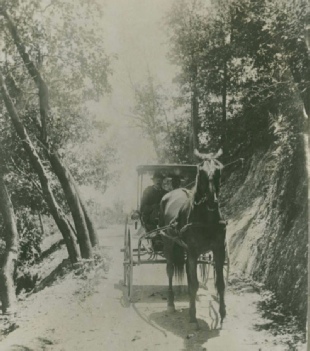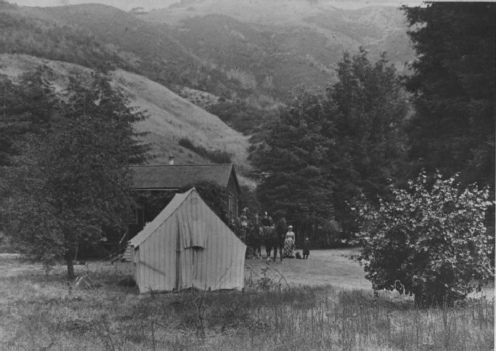























Loading...




San Francisco Summer Training Camps
1917 – Warner Canyon, Mill Valley – Marin County,
1918-1919 – Howard Ranch, Olema – Marin County
1920-1924 – Cazadero Redwoods at Elim Grove, Cazadero, Sonoma County
1917 – Warner Canyon, Mill Valley – Marin County (June 11 to July 9)
In April of 1917 the San Francisco Council sent out flyers to the Scouts indicating that the first summer training camp for the council would be held near the town of Cazadero at Eliim Grove. However for unknown reasons the location could not be secured so the training camp had to be moved at the last minute. The council was able to secure the Mill Valley property of Dr. Alexander Warner for the site of the first training camp.
The first summer training camp run by the San Francisco Council was held in the Warner Canyon area of Mill Valley in June of 1917. Dr. Alexander Warner was the owner of the property and rented it to the Scouts for $210 per year. The camp was attended by 140 boys and their leaders and Scout Executive Raymond O Hanson acted as camp director. Assisting Mr. Hanson as the Camp Adjutant was Homer J. Bemiss, Scoutmaster of Troop 14. Bemiss would ultimately become the future Scout Executive of the Oakland Area Council (from 1920 to 1957) as well as the longest tenured Scout Executive in the Bay Area even until this day.
Each day the boys would be instructed in five hours of Scout craft, first aid, agriculture and signaling. Eighty-five of the boys earned the special War Emergency Badges for completing their requirements. The Scouts camped in large tents that held seven Scouts each with a leader in charge of each tent. The tent group rather than the Scout Troop unit was made the basis for the camp organization. On the fourth of July the boys went into the city of Mill valley and participated in the 4th of July Parade. Later that evening, the Scouts made quite an impression upon the public with a presentation of a camp play at the Mill Valley theater and cleared $25.00 towards their camp expenses.
The following report was submitted to the Executive Board on July 19, 1917 by Scout Executive Raymond O Hanson regarding the Training Camp:
“In order that the Committee may have a general idea of the routine of the camp, I shall outline just briefly the daily program.
At 6:30 o’clock every morning reveille was sounded and the boys were given fifteen minutes in which to rise, dress wash and take their place in line for roll call. Punctuality was insisted upon and the boys who were tardy were placed in what we called the late's line where they remained until breakfast was well under way. No more effective punishment could be devised than this.
At 6:45 flag raising exercises were held., the boys standing at salute while old Glory was hoisted to the top of the pole by a special color guard. The boys then gave the pledge of allegiance to the flag, followed by the singing of the Star Spangled Banner. To participate in such exercise every morning for a month could not fail to inspire the boy with a deeper sense of patriotism and a greater love for his country.
For fifteen minutes prior to breakfast the boys were grilled in calisthenics. Following the morning meal a half hour was given over to camp duty when the boys were required to air their blankets and prepare their tents for morning inspection. Each day a group of boys were assigned to squad duty and were required to clean up the grounds and to perform any other work laid out for them. Following this the boys were instructed for an hour and a half in signaling and first aid, and it was indeed and inspiring sight to see groups of boys scattered all through the hills earnestly engaged in fitting themselves for service and increasing their own scouting efficiency. Scout games were later indulged in as a recreational feature after which the theory of agriculture occupied the remainder of the morning.
Just before dinner, camp inspection was held and a banner was awarded each day to the tent which presented the neatest appearance. Competition was very keen and the inspection very rigid. On several occasions when Army officers were visitors at the camp a regulation military inspection was made and this added very much to the dignity of this feature of camp life.
The afternoon was usually give over to hikes and the passing of Scout tasks. Two showers were provided for cleanliness and were in constant demand. Occasionally the Scouts were taken on swimming trips and to points of interest in the country round about. The secret of the success of the camp may be attributed largely to the fact that the boys kept busy every moment. The requirements for the second and first class badges and the war Emergency Emblem did not leave much room for idleness.
Every day the boys were drilled in military marching for an hour or more in order that they might be familiar with military tactics and able to co-operate effectively with the soldiers in case of war emergency.
One of the most enjoyable features of the camp life was the camp fire every evening around which the boys grouped themselves together while they participated in a program consisting of songs, scout yells, stories and the like. At 9:15 the boys began preparations for the night and at the sounding of taps at 9:30 lights were put out and the boys rested from a strenuous day of profitable as well as enjoyable activity.”
In September the Warner Canyon site was also used again as a weekend camp site for three days of training in Scout craft. The Warner site was used sporadically during the first year as a weekend campsite, but the summer camp would move to a new location the following year due to issues with renting the property.